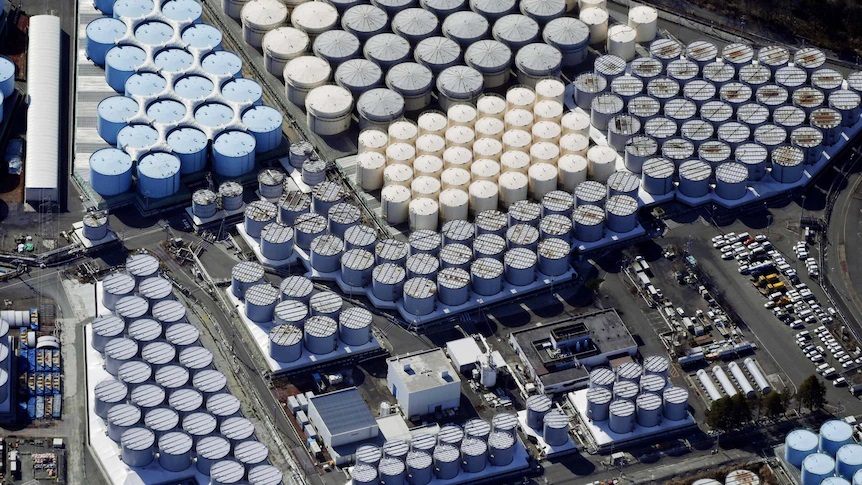Fish that swim in treated wastewater from the tsunami-damaged Fukushima nuclear plant would be safe to eat, according to an expert who is part of the Pacific islands scientific panel that criticised Japan’s plan to discharge the water into the ocean.
The plan to release Fukushima water over four decades into the Pacific has been a source of concern about possible environmental and health risks for nearby countries such as South Korea and China, as well as Pacific island nations.
However, some scientists say the worries are based on misinformation. A few Pacific leaders now back Japan’s plan after briefings from Japanese officials on the process for removing radioactivity.
“We are talking much, much, much less [radioactivity] than is allowed in drinking water around the world. Would I eat the fish? Yes, I would,” Tony Hooker, director of the Centre for Radiation Research at the University of Adelaide in Australia, said at a briefing on Wednesday.
Water used to cool the nuclear reactors damaged in a 2011 earthquake and tsunami is stored in hundreds of large tanks at the coastal Fukushima plant, and its operator Tokyo Electric Power Company has said room is fast running out. Treatment and discharge of the water is part of a decades-long plan to decommission the plant.
Japan is likely to carry out its first release of the wastewater during its summer, according to Hooker, who spoke at an online panel organised by New Zealand’s government-funded Science Media Centre. Tokyo Electric has been carrying out tests this month, using uncontaminated water, of equipment to dilute and pipe the wastewater out to sea.
Hooker said he would stop short of drinking the treated water, but not because it’s dangerous.
“Would I drink the water? No, because it’s sea water,” he said.
Hooker is a member of an expert panel appointed in March by the Pacific Islands Forum, a regional organisation of island nations, to review Japan’s plan and provide technical advice.
The Forum’s Secretary General, Henry Puna, said in January that release of the water could “damage our livelihoods, our fisheries livelihoods, our livelihood as people who are very much dependent and connected to the ocean.”
The panel criticised the quality of data it had received from Tokyo Electric on the water in the tanks and expressed doubts about how well the purification process works. It called for an alternative storage method for the waste water such as making concrete with it.
Hooker was not representing the panel at the online briefing.
Japan’s decontamination plan for the water involves putting it through a purification process known as the Advanced Liquid Processing System, which it says will reduce radioactive elements except tritium to below regulatory levels. The nuclear waste produced by that process will be stored by Japan.
The treated water would then be diluted by more than 100 times to reduce the level of tritium–radioactive hydrogen used to create glow-in-the-dark lighting that’s at the mild end of the radioactive spectrum.
The International Atomic Energy Agency has said the Fukushima process is technically feasible and in line with international practice.
David Krofcheck, a nuclear physicist at the University of Auckland, said removal of the “nasty” products of nuclear fission such as strontium and cesium is the more crucial issue versus naturally occuring tritium.
Even though outside laboratories can verify Japan’s efforts, diplomatically it could benefit from more collaboration with neighboring countries, Krofcheck said.
“There is a lot of trust that has been lost from early on [in the Fukushima disaster] that the Japanese scientists are doing this correctly,” he said.
“It would be nice if there was some kind of international collaboration from people in the neighborhood like Korea, Taiwan, China perhaps,” Krofcheck said. “I think that would smooth some of the hard feelings.”
Chau-Ron Wu, a North Pacific Ocean currents expert at Taiwan research institute Academia Sinica, provided modeling for the online briefing that suggested tritium released from Fukushima would take a year to reach Taiwan’s coastal waters and two to three years to reach the west coast of North America.
Tritium occurs naturally in the environment due to the sun’s energy hitting the earth and is also emitted by the world’s nuclear power plants. Some remains from atmospheric nuclear tests in the 1950s and 1960s.
The Pacific Ocean contains about 8.4 kilograms of tritium and Japan’s plan would add less than 0.1 gram a year, according to a statement from Nigel Marks, a nuclear materials scientist at Australia’s Curtin University.
He said there is more radiation in a banana than would be absorbed by fish from treated Fukushima water.
SOURCE: RFA/PACNEWS














